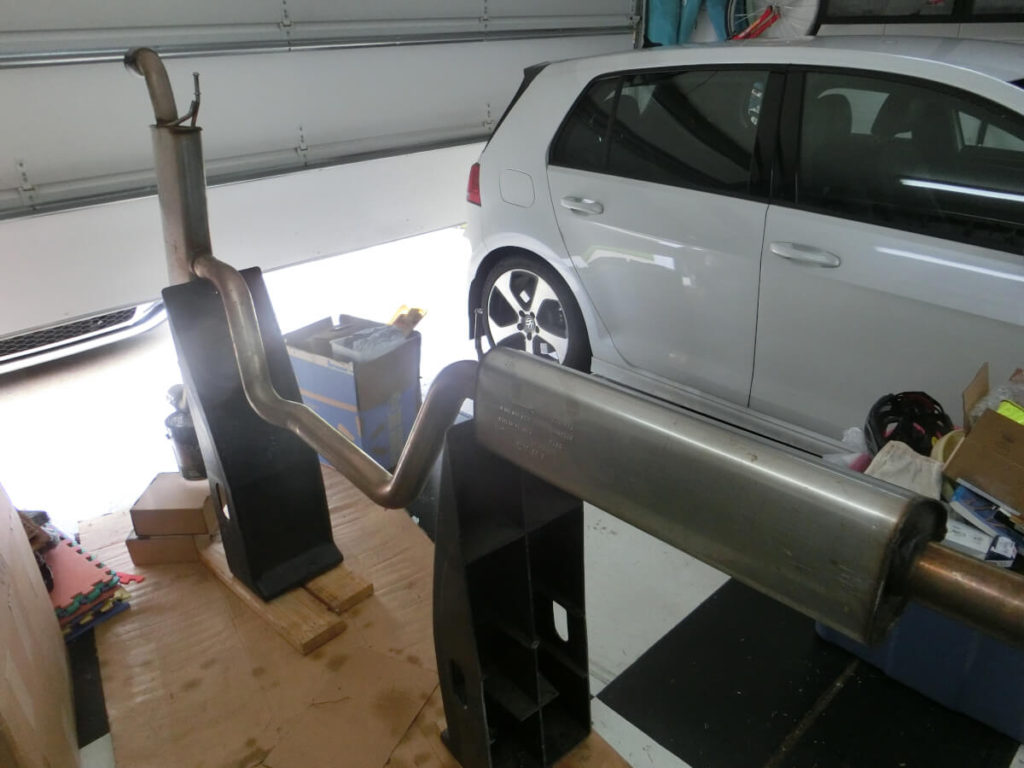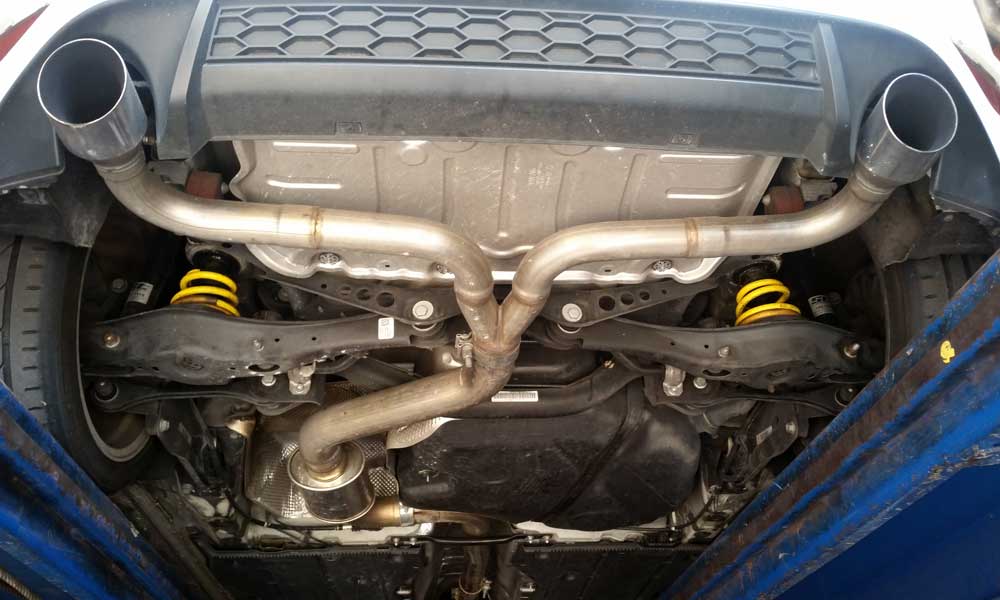Background:
Mk7 GTI stock parts that I have tested generally have shown room for improvement by the aftermarket vendors. The stock catback exhaust is a part that seems to be a good candidate for performance enhancement.
Looking through some Mk7 GTI discussion boards for evidence of how the stock catback performs versus an aftermarket exhaust did not turn up any comparison data.
I found some people advocating that the stock exhaust leaves little room for improvement:
“Stock exhaust flows well enough, a catback won’t even get you gains.” – golfmk7.com forum member
“Cat back exhaust- Dual tips, quad tips, ten tips! It doesn’t matter, the stock catback is not a restriction even at 450+whp.” – golfmk7.com forum member
My GTI was purchased used and already had an aftermarket exhaust which meant I would be waiting for an opportunity to find a stock exhaust before I could test one.
Another GTI owner local to me was moving and had the stock exhaust that they were looking to get rid of, score!
I can confirm that the stock GTI exhaust will fit inside the GTI for transport.
Test Procedure:
To test the exhaust it is being joined with the Trackslag downpipe and the pair are then tested using a flow bench.
To make a comparison the Trackslag downpipe is then joined to my aftermarket exhaust to measure the aftermarket exhaust flow data.
My exhaust consists of a Baun Performance mid-pipe with Vibrant resonator that is sized to fit with the Trackslag DP and the AWE Track Edition exhaust muffler section.
The AWE Track Edition exhaust muffler section was modified with a Vibrant Ultra Quiet resonator, shown below, and then later the resonator was replaced by a Magnaflow muffler.
Both the stock GTI exhaust and the aftermarket exhaust are tested at 16″ of H2O with the bench blowing air through the exhaust system.
Test Results:
The Trackslag combined with the stock GTI exhaust flow 222 CFM @ 16″ of H2O.
The Trackslag and aftermarket exhaust flow 388 CFM @ 16″ of H2O. This is approximately 75% more airflow at the test depression than the stock exhaust.
These results along with the Trackslag downpipe-only flow rate are shown in the chart:
Conclusion:
The stock Mk7 GTI exhaust was flow tested and compared with an aftermarket exhaust. The stock exhaust flows 222 CFM @ 16″ of H2O and the aftermarket exhaust flows 388 CFM @ 16″ of H2O.
The aftermarket exhaust adds some restriction to the downpipe, leading to an approximately 10% decrease in airflow at the test depression. The addition of the stock exhaust with the downpipe led to an approximately 50% decrease in airflow.
The GTI stock exhaust flows significantly less than an aftermarket exhaust when tested as described above.







How much impact do you think this airflow decrease with GTI stock exhaust vs aftermarket (about 40%) will be in HP/LB FT? 5HP? 12hp?
Probably less than this downpipe swap.
I doubt there’s a set number, as the engine power output goes up I would expect the power gain to increase.
I’m curious how much CFM the 2.0 TSI with a is38 is pushing. if its less than the 222cfm then having more is just not needed. 🙂
The test depression is fixed for ease of testing by setting a reference value (16″ of H2O in this case) that the parts can be compared at. In practice what we are interested in is pressure drop, aka exhaust backpressure.
You’re suggesting that if the backpressure caused by the exhaust is xx psi that there is no benefit to having less backpressure in the exhaust? The power generated by the turbocharger is a function of the expansion ratio across the turbine wheel, if you can improve the power output by lowering the exhaust backpressure, without impacting engine efficiency, why wouldn’t that be desirable?
First, Jeff, thank you so much for all the work you put in to attempt to provide unbiased information to the community. Your time and effort is noticed and appreciated.
The sentiment that a catback exhaust is not required is shared commonly around forums and something I have observed with my personal car. You asked the question, though, about why this might not be desirable. Speaking personally, I cannot stand loud cars and purchased one of the few catted and resonated downpipes on the market with the original intention of mating this with my stock catback. Outside of dropping some serious cash on a Remus exhaust, there just is not a catback option I am aware of that retains the quiet, mature sound my car has now.
Outside of a possible loss of power, is there a conversation to be had that by NOT replacing the catback exhaust we are causing premature wear to the turbocharger?
Hey Riley, thanks for the feedback, I appreciate knowing others are finding the information useful.
As someone who added a resonator and larger muffler to my exhaust, I can appreciate the desire to keep the sound subdued.
I don’t think a stock exhaust would affect the longevity of the turbocharger. The pressure difference between stock and aftermarket is not very substantial relative to the operating pressure of the turbo.
I think we should also look into the weight difference between the stock and aftermarket exhaust.
I’ll take a measurement of the stock exhaust. I would not be surprised if the difference is not very large. It’ll be a while before I have the aftermarket exhaust off my car to make a comparison.
The one I have is 42 lbs.